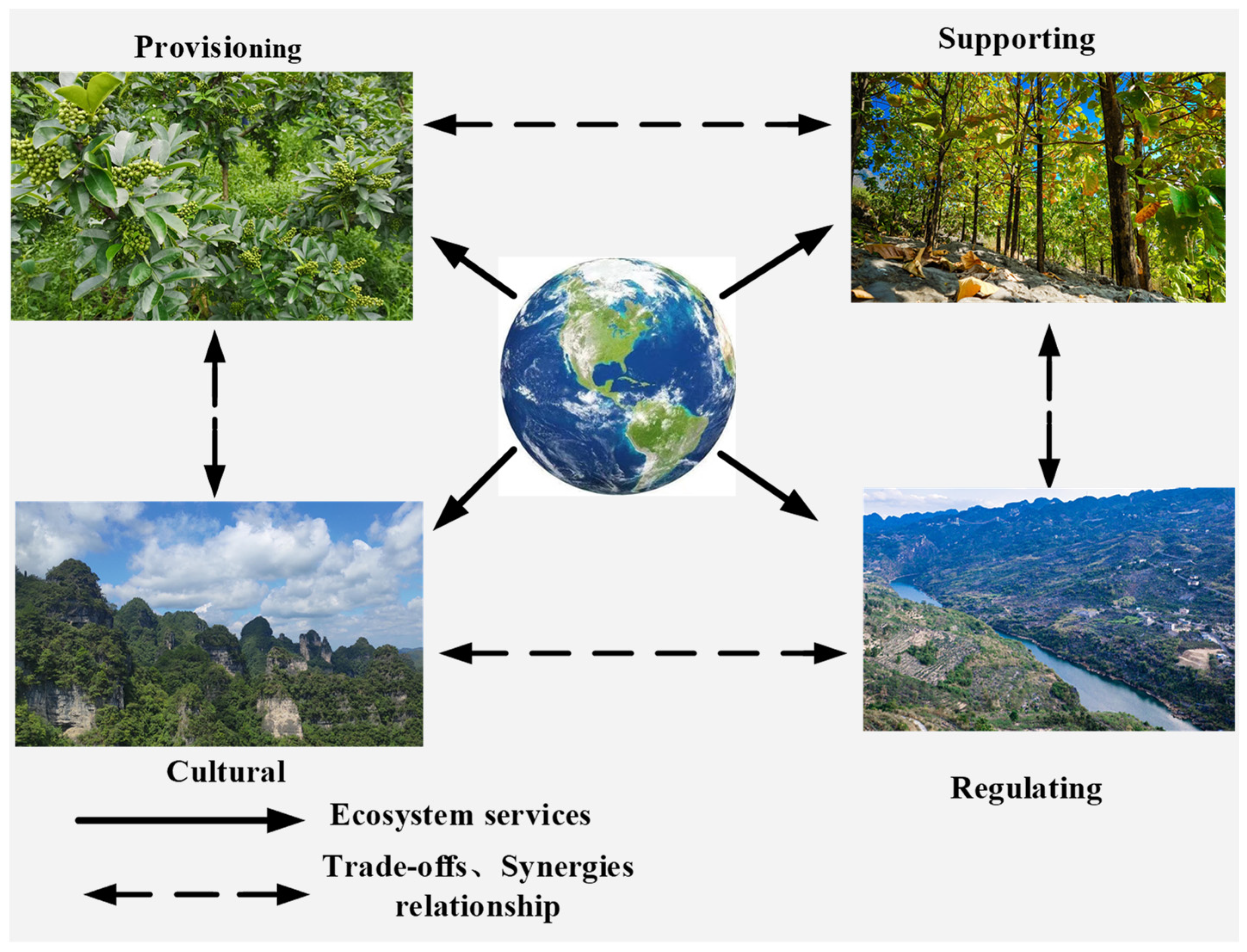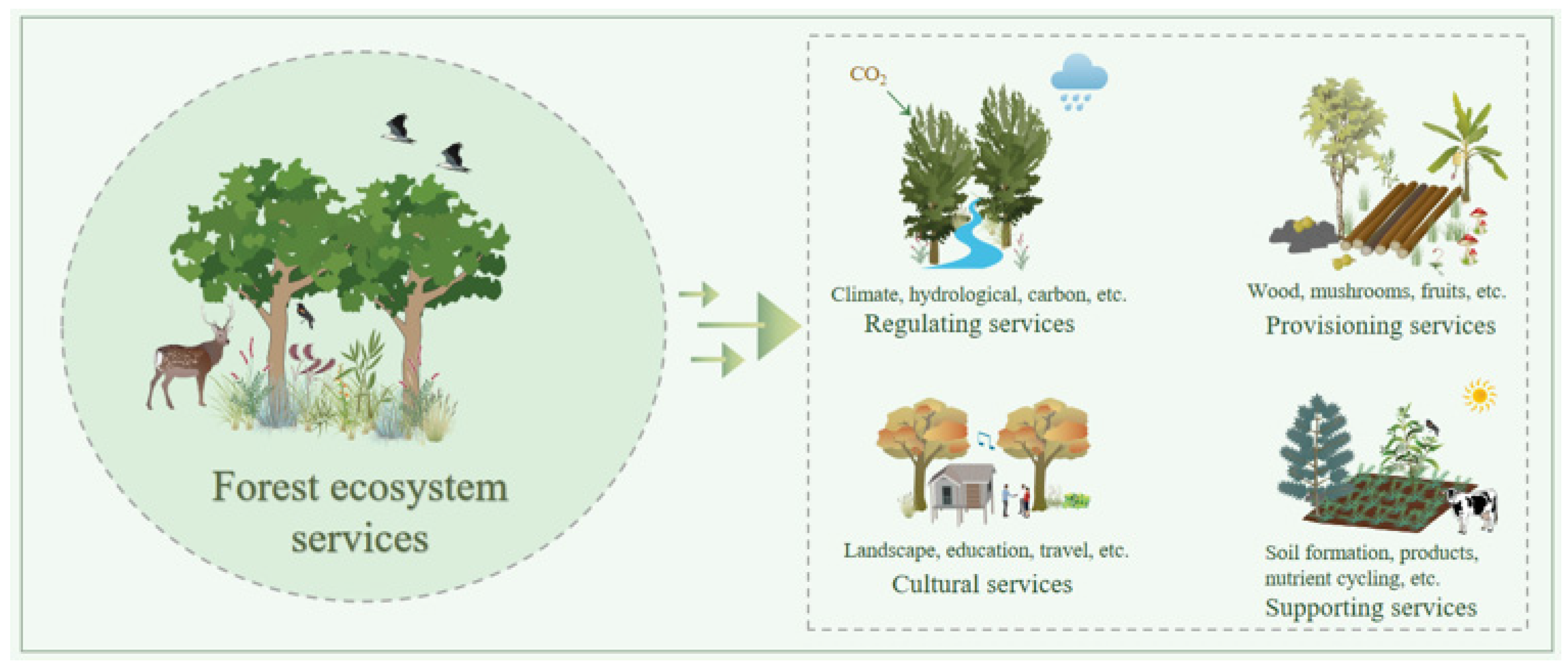
| Version | Summary | Created by | Modification | Content Size | Created at | Operation |
|---|---|---|---|---|---|---|
| 1 | Xuehua Deng | -- | 2116 | 2023-03-12 03:56:40 | | | |
| 2 | Lindsay Dong | Meta information modification | 2116 | 2023-03-13 02:32:56 | | |
Video Upload Options
Ecosystem services, as the term of a scientific period, began in 1970 with the publication of the UN University’s report on “Human Impact on the Global Environment”. Since then, Costanza has proposed that ecosystem services are benefits derived directly or indirectly by human beings from the ecosystem, which are used to maintain the natural environmental conditions and utilities on which human beings depend for survival and development. Trade-offs, as a fundamental concept, first appeared in economics and were defined as opportunity costs. Where resources are scarce, an individual or group must give up a certain amount of additional scarce resources to obtain more of the scarce resources. Karst desertification refers to the land degradation phenomenon caused by the disturbance and destruction of unreasonable human social and economic activities under the fragile karst environment in the subtropical zone, which is manifested by soil erosion, gradual rock exposure, land productivity degradation, and a desert-like landscape on the surface. The results of management over the years show that forests, as the main provider of ecosystem services, have the functions of water conservation, soil and water conservation, carbon sequestration, and climate change mitigation. In particular, they play an irreplaceable role in managing karst desertification.
1. Ecosystem Service Trade-Off/Synergy
1.1. Spatial and temporal characteristics of ecosystem service trade-off/synergy
1.2. Drivers of ecosystem service trade-off/synergy
1.3. Synergistic relationship of forest ecosystem service trade-offs

2. Optimization of Ecosystem Service Functions
2.1. Ecological compensation
Ecological compensation and payment are differentiated regulation strategies for the interaction between ecosystem services and human welfare, which should be adapted to the current ecological environment and social and economic system. As a mechanism to stimulate ecological construction and environmental protection, ecological compensation can realize the effect of internalizing the external ecological benefits [19]. Through the analysis of the spatial flow of supply, demand, and trade-offs, the key benefits and losses of ecosystem services are obtained, and the conditional payment transaction from service users to service providers is facilitated [20]. In general, a combination of remote sensing data and location-based observations is used to measure the profit and loss of supply, regulation, support, and cultural services. Complementary compensation strategies have been developed based on matching supply, demand, and trade-offs/synergies of ecosystem services. For example, Sun analyzed ecosystem service processes in crucial ecological function areas in Xinjiang. According to the total value of ecosystem services, all counties in the autonomous region can be divided into three compensation levels: priority compensation, secondary compensation, and potential compensation areas [21]. Thus, the efficiency of the ecological compensation mechanism can be improved. It was more difficult to compensate for the particular habitat of the karst desert region, and further funds were used. However, certain shortcomings in financial compensation can result in poor compensation outcomes. As a result, alternative ways to precisely refine and structure economic compensation methods exist such as improving the ecosystem structure stabilization and enhancing ecosystem service functions.
2.2. Enhance forest ecosystem service functions based on site conditions

3. Summary
References
- Haase, D.; Schwarz, N.; Strohbach, M.; Kroll, F.; Seppelt, R. Synergies, trade-offs, and losses of ecosystem services in urban regions: An integrated multiscale framework applied to the Leipzig-Halle Region, Germany. Ecol. Soc. 2012, 17, 22.
- Niu, T.; Yu, J.; Yue, D. The Temporal and Spatial Evolution of Ecosystem Service Synergy/Trade-Offs Based on Ecological Units. Forests 2021, 12, 992.
- Schroder, S.A.; Tóth, S.F.; Deal, R.L.; Ettl, G.J. Multi-objective optimization to evaluate tradeoffs among forest ecosystem services following fire hazard reduction in the Deschutes National Forest, USA. Ecosyst. Serv. 2016, 22, 328–347.
- Chen, J.; Pu, J.; Li, J.; Zhang, T. Trade-off and synergy analysis among ecosystem services in a karst watershed. Geocarto Int. 2022, 1–17.
- Zhang, J.J.; Zhu, W.B.; Zhu, L.Q.; Li, Y.H. Multi-scale analysis of trade-off/synergy effects of forest ecosystem services in the Funiu Mountain Region. Acta Geogr. Sin. 2020, 75, 975–988.
- Han, H.; Yin, C.; Zhang, C.; Gao, H.; Bai, Y. Response of trade-offs and synergies between ecosystem services and land use change in the Karst area. Trop. Ecol. 2019, 60, 230–237.
- Feng, Y.; Cao, Y.G.; Li, S.P.; Wang, S.F.; Liu, S.H.; Bai, Z.K. Trade-offs and synergies of ecosystem services: Development history and research characteristics. J. Agric. Resour. Environ. 2022, 39, 11–25.
- Han, H.Y.; Su, Z.H. Research progress and prospect of karst ecosystem services. Carssologica Sin. 2017, 36, 352–358.
- Chen, T.; Huang, Q.; Wang, Q. Differentiation characteristics and driving factors of ecosystem services relationships in karst mountainous area based on geographic detector modeling: A case study of Guizhou Province. Acta Ecol. Sin. 2022, 42, 6959–6972.
- Yuan, D.X. World Comparison of Karst Ecosystems: Scientific Objectives and Implementation Plan. Adv. Earth Sci. 2001, 16, 461–466.
- Xiong, K.N.; Zhu, D.Y.; Pang, T.; Yu, L.F.; Xue, J.H.; Li, P. Study on Ecological industry technology and demonstration for Karst rocky desertification control of the Karst Plateau-Gorge. Acta Ecol. 2016, 36, 7109–7113.
- Chen, R.; Wang, S.J.; Bai, X.Y. Trade-offs and synergies of ecosystem services in southwestern China. Environ. Eng. Sci. 2020, 37, 669–678.
- Liu, S.J.; Zhang, W.; Wang, K.L.; Pan, F.J.; Yang, S.; Shu, S.Y. Factors controlling accumulation of soil organic carbon along vegetation succession in a typical karst region in Southwest China. Sci. Total Environ. 2015, 521, 52–58.
- Feng, T.; Chen, H.S.; Polyakov, V.O.; Wang, K.L.; Zhang, X.B.; Zhang, W. Soil erosion rates in two karst peak-cluster depression basins of northwest Guangxi, China: Comparison of RUSLE model with 137 Cs measurements. Geomorphology 2016, 253, 217–224.
- Fu, Z.Y.; Chen, H.S.; Xu, Q.X.; Jia, J.T.; Wang, S.; Wang, K.L. Role of epikarst in near-surface hydrological processes in a soil mantled subtropical dolomite karst slope: Implications of field rainfall simulation experiments. Hydrol. Process. 2016, 30, 795–811.
- Zhang, Y. Tree, Shrub, Grass Restoration Mechanism and Characteristic High-efficiency Forestry Model in the Karst Rocky Desertification Control; Guizhou Normal University: Guiyang, China, 2020.
- Wen, X.W.; Quan, J.L.; Wang, R.X.; Fu, L.T. Research Progress of Restoration of Degraded Karst Forest Bank. Mod. Agric. Sci. Technol. 2016, 2, 172–174+177.
- Liu, S.R.; Dai, L.M.; Wen, Y.U.; Wang, H. A review on forest ecosystem management towards ecosystem services: Status, challenges, and future perspectives. Acta Ecol. 2015, 35, 1–9.
- Qiu, J.J.; Liu, Y.H.; Yu, A.L.; Chen, C.J.; Huang, Q.Y. Research progress and prospect of the interrelationship between ecosystem services and human well-being in the context of coupled human and natural system. Prog. Geogr. 2021, 40, 1060–1072.
- Wunder, S. Revisiting the concept of payments for environmental services. Ecol. Econ. 2015, 117, 234–243.
- Sun, Y.F.; Qin, W.; Fan, J.Y. Spatial selection of ecological compensation in key ecological functional areas of Xinjiang. Arid Land Geogr. 2021, 44, 565–573.
- Wang, K.L.; Chen, H.S.; Yue, Y.M. Experiment and Demonstration on Degraded Mechanism and Its Adaptive Restoration of Karst Ecosystems in Northwest Guang xi. Sci. Technol. Promot. Dev. 2015, 3, 179–183.
- Yu, Y.H.; Li, G.R.; Pi, F.J.; Yan, L.B.; Yu, L.F.; Huang, Z.S. Evaluation of water conservation function of main forests in the upper reaches of Chishui River. J. Soil Water Conserv. 2015, 29, 150–156.
- Chen, W. Mechanism of Community Configuration and Optimized Regulation Technologies of Forest, Shrub and Grass in the Karst Rocky Desertification Control. Master’s Thesis, Guizhou Normal University, Guiyang, China, 2019.
- Zhang, S.H. Succession Law of Plant Communities and Structural Management Techniques in the Karst Rocky Desertification. Master’s Thesis, Guizhou Normal University, Guiyang, China, 2020.
- Zou, Z.; Zeng, F.; Wang, K.; Zeng, Z.; Zhao, L.; Du, H.; Zhang, F.; Zhang, H. Emergy and Economic Evaluation of Seven Typical Agroforestry Planting Patterns in the Karst Region of Southwest China. Forests 2019, 10, 138.
- Wang, R.; Cai, Y.L. A model for remediation of degraded ecosystems in karst areas of southwest China. J. Appl. Ecol. 2010, 21, 1070–1080.
- Peng, W.X.; Wang, K.L.; Song, T.Q.; Zeng, F.P.; Wang, J.R. Controlling and restoration models of complex degradation of vulnerable Karst ecosystem. Acta Ecol. Sin. 2008, 28, 811–820.
- Yang, S.M.; Xiong, K.N.; Yu, Y.H.; Liu, X.Y.; Dong, X.C. Diagnosis and adjustment of forest and grass vegetation restoration patterns in karst rocky desertifification areas in China. World For. Res. 2017, 30, 91–96.
- Sheng, M.Y.; Xiong, K.N.; Cui, G.Y.; Liu, Y. Plant diversity and soil physical-chemical properties in karst rocky desertification ecosystem of Guizhou, China. Acta Ecol. 2015, 35, 434–448.
- Wang, K.L.; Yue, Y.M.; Chen, H.S.; Wu, X.B.; Xiao, J.; Qi, X.K.; Zhang, W.; Du, H. The comprehensive treatment of karst rocky desertification and its regional restoration effects. Acta Ecol. Sin. 2019, 39, 7432–7440.
- MacDicken, K.G.; Sola, P.; Hall, J.E.; Sabogal, C.; Tadoum, M.; de Wasseige, C. Global progress toward sustainable forest management. For. Ecol. Manag. 2015, 352, 47–56.
- Han, H.Q.; Yang, J.Q.; Chen, S.Y.; Xu, J.; Wang, T.G.; Hou, J.W. Spatial Grain Size Effect of Trade-off Synergy Relationship Between Fresh water Ecosystem Services in Karst Mountainous Areas. J. Univ. Jinan Sci. Technol. 2022, 36, 45–55.




